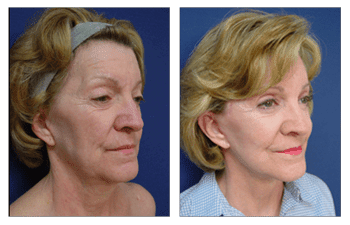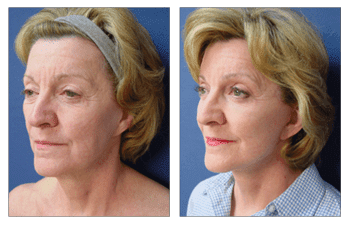



Introduction: Fat Transfer for Facelift Alternative
As we age, various soft tissue components drop precipitously. These components include a reduction in infrastructural collagen pillars, fat volumes, and a recoil protein called elastin. These undesirable changes result in the deflation and subsequent sagging of the facial soft tissues. Depending on your age and health, a facelift may be a necessary recommendation. However, younger patients and those of poor health may consider fat transfer as a facelift alternative. Interestingly, some patients may supplement this facelift with fat grafting.
Each patient’s case requires a unique evaluation to determine the best facial rejuvenation option. consideration and their differences should be respected to achieve the desired goal of the patient. Once fat transfer is selected as your desired rejuvenation plan, volumes and locations of fat transfer must be determined. Details of fat transfer are dependent on each patient’s unique needs and guided by gender aesthetics.
Fat grafting, also known as fat transfer, requires knowledge of anatomy as well as the different aesthetic needs of male versus female faces. Routine transferred fat volumes range from 10 to 50cc’s and are dictated by each patient’s desired goals. Now, let’s dive deeper into fat transfer.
Fat transfer or facelift?
Fat transfer and facelift are both cosmetic procedures aimed at achieving a more youthful facial appearance, but they work in different ways to achieve their goals.
A fat transfer involves the removal of fat from one area of the body (usually the abdomen or thighs) and injecting it into the face to add volume or fill in wrinkles and fine lines. This procedure can improve facial contours, rejuvenate the skin, and restore a more youthful appearance.
On the other hand, a facelift, also known as rhytidectomy, is a surgical procedure that focuses on lifting and tightening the skin and underlying muscles of the face and neck to reduce sagging, wrinkles, and other signs of aging. This procedure can provide a more dramatic and longer-lasting improvement in facial appearance compared to a fat transfer.
In some cases, a combination of fat transfer and facelift can be performed to achieve more comprehensive and natural-looking results. The fat transfer can enhance volume and smooth out wrinkles, while the facelift addresses the sagging and tightening of the skin and muscles. This combination procedure can lead to a more harmonious and youthful facial rejuvenation.
Facial Fat Transfer or Dermal Fillers?
Facial fat transfer and dermal fillers both offer benefits and drawbacks for restoring facial volume and addressing signs of aging.
Facial fat transfer involves harvesting fat from another area of the body and injecting it into the face. This natural approach provides long-lasting results and potentially permanent improvements. However, it may require multiple sessions and has a longer recovery time.
On the other hand, dermal fillers use synthetic or natural substances to add volume to the face. They offer immediate results with minimal downtime but may need to be repeated every 6-18 months. Additionally, there is a risk of allergic reactions or lumps forming at the injection site.
When deciding between the two options, key factors to consider include longevity of results, recovery time, and the naturalness of the outcome. Real-life patient experiences with facial fat transfer have shown natural-looking, long-lasting results, while dermal fillers have provided immediate improvement with minimal downtime but require regular maintenance.
Ultimately, the choice between facial fat transfer and dermal fillers depends on the individual’s preferences and desired outcomes.
How is Facial Fat Grafting Performed?
Facial fat grafting, also known as fat transfer or autologous fat transplantation, is a cosmetic procedure that involves taking fat from one area of the body and injecting it into the face to restore volume, improve contours, and rejuvenate the appearance. This procedure can provide natural-looking results that can last for many years. During facial fat grafting, fat is harvested from the patient’s own body through liposuction, usually from areas like the abdomen, thighs, or hips.
The collected fat is then processed to purify it before being carefully injected into the desired areas of the face, such as the cheeks, temples, or jawline, to enhance facial fullness and contour. The technique requires precision and skill to ensure that the fat is distributed evenly and integrates seamlessly with the facial tissues. Overall, facial fat grafting is a minimally invasive procedure that offers a safe and effective way to restore youthful volume and definition to the face.
Harvesting
Fat harvesting is a procedure commonly used in cosmetic and reconstructive surgeries. The process begins with the administration of local anesthetic to the donor site, typically the abdomen, thighs, or buttocks, where excess fat is present. Once the area is numbed, a small incision is made to access the fat.
A cannula, a thin tube with a blunt tip, is inserted through the incision to carefully break up and loosen the fat cells. The cannula is then connected to a suction device, which gently removes the fat from the body. The surgeon needs to be gentle and precise during this process to ensure the viability of the harvested fat cells.
The extracted fat is then processed and purified before it can be used for fat transfer procedures, such as fat grafting in cosmetic surgeries like breast augmentation or facial rejuvenation. The use of local anesthetic helps to minimize discomfort and the risk of complications during fat harvesting.
Overall, fat harvesting involves the careful removal of excess fat from a specific donor area using a cannula and local anesthetic, followed by the processing of the harvested fat for use in various cosmetic and reconstructive procedures.
Purification and Transfer
Fat purification and transfer for fat injection is a process that involves harvesting excess fat from one part of the body, purifying it to remove impurities, and then transferring it to another area for augmentation. The purification step is crucial to ensure a safe and successful procedure. Impurities such as blood, oil, and other non-fat tissue are removed to prevent complications such as infection or inflammation.
After purification, the fat cells are carefully prepared and transferred into small syringes, taking into consideration any comorbidities the patient may have. This step involves meticulous attention to detail to ensure that the fat cells remain viable and undamaged during the transfer process.
Facial fat transfer requires certain criteria to be met, including being at a healthy, stable weight and having enough body fat to harvest. It is important to assess the patient’s overall health and suitability for the procedure to minimize risks and achieve the desired results.
Overall, the purification and transfer of fat cells for fat injection is a delicate process that requires expertise and precision to ensure a safe and successful outcome for the patient.
What is Facial Fat Grafting?
Facial fat grafting is a cosmetic procedure that involves transferring fat from one part of the body to the face in order to add volume, fill in wrinkles, and improve overall facial harmony. This technique provides several benefits, including natural-looking results, long-lasting effects, and the added benefit of body contouring in the area where the fat is harvested. Compared to traditional facelifts, facial fat grafting is generally safer and more effective, as it uses the body’s own natural fat cells to rejuvenate the face.
The facial fat grafting procedure begins with the harvesting of fat from areas such as the abdomen, thighs, or buttocks. The harvested fat is then filtered to remove impurities and excess fluids before being carefully injected into targeted areas of the face to enhance volume and improve contours. The various stages of the fat grafting process include consultation, harvesting, processing, and injection. Overall, facial fat grafting provides a safe and effective way to achieve natural-looking facial rejuvenation with long-lasting results.
Pros & Cons of Facial Fat Grafting
Facial fat grafting, also known as fat transfer, offers several benefits. One major advantage is that it provides natural-looking results since it uses the patient’s own fat to fill and contour the face. Additionally, the anti-aging effects of facial fat grafting can be longer-lasting compared to other facial filling procedures.
However, this procedure also comes with potential risks and considerations. One risk is the possibility of lumps or irregularities in the treated areas, although this can be minimized with an experienced plastic surgeon. Additionally, there is a need for recovery time as swelling and bruising are common after the procedure.
It’s important to discuss the procedure with a qualified plastic surgeon to ensure that the patient understands the process, potential risks, and expected outcomes. Overall, facial fat grafting can offer natural and long-lasting results, but it’s crucial to carefully consider the potential risks and choose a skilled surgeon to achieve the best possible outcome.
What are alternative, nonsurgical facelift options?
A nonsurgical facelift refers to a range of cosmetic procedures designed to rejuvenate the face without the need for surgery. These procedures often target wrinkles, fine lines, and sagging skin to achieve a more youthful appearance.
Botulinum toxin injections, commonly known as Botox, are used to relax facial muscles, reducing the appearance of wrinkles and fine lines. The purpose of this procedure is to smooth out the skin and promote a more youthful look, with results typically lasting for several months.
Chemical peels involve applying a chemical solution to the skin to exfoliate and remove dead skin cells, resulting in a smoother, more even skin tone. This procedure can improve the appearance of acne scars, age spots, and sun-damaged skin.
Dermal fillers are injected into the skin to add volume and plump up areas that have lost elasticity, such as the cheeks and lips. The goal is to restore youthful contours and minimize the appearance of lines and wrinkles.
Fat injections involve transferring fat from one part of the body to the face to plump up areas that have lost volume, providing natural-looking results.
Laser skin resurfacing uses laser technology to remove damaged skin layers and stimulate the production of collagen, resulting in smoother, firmer skin.
Internal radiofrequency treatments have become the mainstay of nonsurgical facelifts. By applying radiofrequency energy from under the skin it is feasible to tighten the collagen molecules in the fibroseptal network and dermal skin undersurface.
Overall, nonsurgical facelift procedures aim to improve skin texture, restore volume, and reduce the signs of aging, providing natural-looking and long-lasting results
Conclusion: Fat Graft for Facelift Alternative
Fat grafting as an alternative to a facelift offers several advantages, including reduced risk of skin necrosis and a shorter recovery time. By using the patient’s fat to restore volume and contour to the face, there is a decreased chance of tissue rejection and complications associated with foreign implants. Additionally, fat grafting can provide a more natural and long-lasting result compared to fillers or implants.
However, there are also some drawbacks to fat grafting. The procedure may require multiple sessions to achieve the desired results, and not all of the transferred fat may survive, leading to potential asymmetry or uneven results.
Combining fat transfer with a facelift can provide both lifting and volumizing effects, allowing for a more comprehensive rejuvenation of the face. Once the excess skin is removed during the facelift, the strategic placement of fat grafts can help restore lost volume and enhance the overall results.
In conclusion, fat grafting offers several advantages as an alternative to a facelift, but it can also be combined with a facelift to achieve optimal lifting and volumizing effects for a more comprehensive facial rejuvenation.
For fat transfer with facelift cases, the transferred fat allows surgeons to have the ability to restore volumetric highlights and contours that just repositioning tissues with a lift cannot provide.
The need for fat transfer for facelift alternatives is a reality in 2024 and has become more popular following an understanding that facial aging is affected by volume loss as much as sagging tissues.
Please appreciate our 70-year-old female who underwent a simultaneous facelift and fat transfer.
